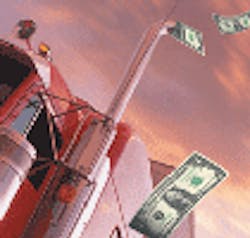Bankruptcy in the trucking industry increased significantly in 2007, and a pessimistic outlook for 2008 has left carriers, especially those with small fleets, worried about the need to seek Chapter 11 protection. But declaring bankruptcy is just the first step in what can be a complex process.
For example, Spencer Fane Britt Browne LLP, represented two carriers, Rocor International and Arctic Express, in Chapter 11 bankruptcy proceedings after they were named in class action suits by the Owner-Operator Independent Drivers Association (OOIDA).
The suits sought to recover unreturned maintenance account balances from truck leases from carriers in Chapter 11 reorganizations. OOIDA alleged the carriers didn’t comply with federal leasing requirements. The firm was able to get OOIDA to waive the claims against Rocor and Arctic in return for structured payments to be paid over several years.
Dan Doyle, an attorney at Spencer, Fane, Britt Browne LLP, spoke to Fleet Owner about the risks of bankruptcy, and the ways to exit bankruptcy and ways to avoid having to declare it in the first place.
“The obvious preventative measure is to be profitable,” Doyle said. “The real challenge in running a fleet is keeping track of the most profitable routes. Fleets run into problems when they don’t know their profit margin until the end of the year.
“They need to know what costs and overhead are because they tend to work to drive revenues up without realizing what it will do to costs,” he added. “They’ll get a big new shipping client, but they don’t know what it’ll cost.”
Doyle generally discourages filing for bankruptcy in all but the direst circumstances. “Bankruptcy is the best option when you’re faced with something that could shut you down overnight, like the OOIDA cases,” he said. “However, you should walk away entirely when secured claims are larger than what you can possibly make.”
When bankruptcy is unavoidable, Doyle said companies have at least some options. “We’ve either sold through auction and gotten equity for the owners, pushing money to the unsecured claims and finishing deliveries, or doing what Arctic did, which is reorganize, reject bad contracts, and be better with their routes,” he said.
“Renegotiating is bad at this time with diesel prices as bad as they are. Hopefully carriers have fixed rates, because fuel has become a big problem in regard to profitability. But it’s cyclical. Three years ago, everyone was making money. But it’s slowed and capacity has caught up.”
